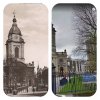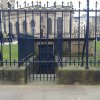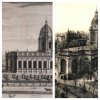-
Welcome to this forum . We are a worldwide group with a common interest in Birmingham and its history. While here, please follow a few simple rules. We ask that you respect other members, thank those who have helped you and please keep your contributions on-topic with the thread.
We do hope you enjoy your visit. BHF Admin Team
You are using an out of date browser. It may not display this or other websites correctly.
You should upgrade or use an alternative browser.
You should upgrade or use an alternative browser.
St Phillips Church Cathedral
- Thread starter Astonian
- Start date
A very good commemorative film celebrating the Church/Cathedral's 300th anniversary. Viv.
https://historywm.com/films/celebra...rmingham-the-church-which-became-a-cathedral/
https://historywm.com/films/celebra...rmingham-the-church-which-became-a-cathedral/
Key Hill Brian
Proud Brummie
Entrance to a private family Crypt. Someone with some money & wished to show it off!
That was a monumental head stone with the spiral it was a square block on a slightly built step up on to it
With a inlaid stone written plaque this was very early years in brum of a person with gold writing
Obvisious it was a Birmingham member of the society possible 1800/1900 hundreds
It was an up right building as you can see it was about three meters square block
And very high built possible a member of the st Phillips church of high cannon,in sh postion
And there built within it was a tap with a metal deep cup on a heavy chain and a little troth for the cup
Or if you like I would say in those days a chalice type metal cup that was there from the early years right up until about
The mid 1950,s when it was removed as some of the graves of the 1800.s was removed and replacing and placing of the walk way
I believe the ground slab of the littliest person in Birmingham was buried on the approaching of the church patches before redeleoping the pathway was removed from the ground and taken away what happen end to the remains I do not know
But that to we you call it was the during tap for the people I recall this and drank from it as a nippe . Best wishes Astonian,,,,
With a inlaid stone written plaque this was very early years in brum of a person with gold writing
Obvisious it was a Birmingham member of the society possible 1800/1900 hundreds
It was an up right building as you can see it was about three meters square block
And very high built possible a member of the st Phillips church of high cannon,in sh postion
And there built within it was a tap with a metal deep cup on a heavy chain and a little troth for the cup
Or if you like I would say in those days a chalice type metal cup that was there from the early years right up until about
The mid 1950,s when it was removed as some of the graves of the 1800.s was removed and replacing and placing of the walk way
I believe the ground slab of the littliest person in Birmingham was buried on the approaching of the church patches before redeleoping the pathway was removed from the ground and taken away what happen end to the remains I do not know
But that to we you call it was the during tap for the people I recall this and drank from it as a nippe . Best wishes Astonian,,,,
Lady Penelope
master brummie
I remember the grave of the little person. My Dad remarked on it but I thought the stone was still there. I think it used to be over towards the corner by the Joint Stock. Or am I dreaming again?
pjmburns
master brummie
There is a thread on Nanetta Stocker (the littlest person) here https://birminghamhistory.co.uk/forum/showthread.php?31368-Little-Nannete-Stocker
Janice
Janice
Grea
master brummie
Extracts from a discussion about the structure in the photo below in the gardens of Highfield House, Selly Park have been copied to this and the three subsequent posts below. This structure is believed to have been constructed using stones and carvings from the apse of St Phillips Church. The full discussion is here.
https://birminghamhistory.co.uk/for...s-arch-in-selly-park.47601/page-3#post-588370
SPF4EVER. this may be a better photo G'
https://birminghamhistory.co.uk/for...s-arch-in-selly-park.47601/page-3#post-588370
SPF4EVER. this may be a better photo G'
Attachments
oldMohawk
gone but not forgotten
I'm not an expert in this subject but am interested in who built the arch and found this in a Google Books Article. If it is the 'mysterious arch' then the source of the stonework is interesting.

selly park fields forever
Son of the fields
Vivienne that's a fantastic further confirmation of where the arch came from. Clearly the rear elevation was transplanted to Highfield in Selly Park - or the majority of it at least. Nice one. SPF4EVER
Must have been a fair expense too to take it apart and rebuild it somewhere else. I also wondered if the old stones would have been 'dumped' if Highfield hadn't stepped in. Viv.
selly park fields forever
Son of the fields
Viv - indeed the question that remains in my mind too - why ? Just because it looked good ? Being from a (then) church, for spiritual reasons ? Like you say - must have been a fair expense to take it apart and rebuild it somewhere else (?) Very intriguing. May be we'll never know - may be it was all in the greater scheme of 'second city celestial serendipity' in Selly Park ?Must have been a fair expense too to take it apart and rebuild it somewhere else. I also wondered if the old stones would have been 'dumped' if Highfield hadn't stepped in. Viv.
selly park fields forever
Son of the fields
I have found there is a company up in Durham (Harrison & Harrison Ltd, St John's Rd, Meadowfield, Durham, DH7 8YH, Telephone: 0191 378 22 22, [email protected]) whose founder was no less than Thomas Hugh Harrison (born 1839.) Could this be the very Thomas Harrison who was registered as living in Highfield 1890 to 1905 ? He would have been 51 - feasible. SPF4EVER
Lady Penelope
master brummie
I'm not sure where the records are for St Philip's are. Some church records are in the archives and others with the Diocesan Office. I'm sure they would have had to apply for a faculty to make any alterations to the building (you have to have one just to knock a nail in a C of E church wall) and this would be with the records. I wonder where Mr Harrison went to church?
cookie273uk
Gone but not forgotten
Is it Saint Phillip's Church 0r Cathedral ?, I have heard it called both, I have painted it a few times and always titled it Cathedral
Hi Eric. It was a church until 1905 after which it was made a cathedral. This is an extract from the Cathedral website
"St Philip's remained a church until 1905 when the new Diocese of Birmingham was created with Charles Gore as the first Bishop. Rather than fund a new cathedral building Bishop Gore decided to use an existing church as the cathedral and seat of the Bishop. As a Christian Socialist Gore was acutely aware of the poverty and social problems facing many ordinary citizens. It was at this time that a Bishop’s throne and canon’s stalls were installed as well as electric lighting"
Viv.
"St Philip's remained a church until 1905 when the new Diocese of Birmingham was created with Charles Gore as the first Bishop. Rather than fund a new cathedral building Bishop Gore decided to use an existing church as the cathedral and seat of the Bishop. As a Christian Socialist Gore was acutely aware of the poverty and social problems facing many ordinary citizens. It was at this time that a Bishop’s throne and canon’s stalls were installed as well as electric lighting"
Viv.
cookie273uk
Gone but not forgotten
Lovely Eric. Very much how I remember it when walking past it to and from work. I think it was a good decision to keep this as the Cathedral when it was changed from a church rather than build anew. Viv.
S








